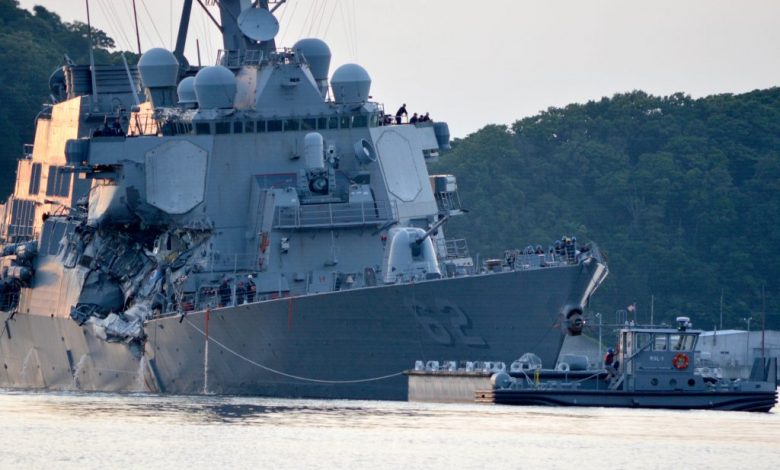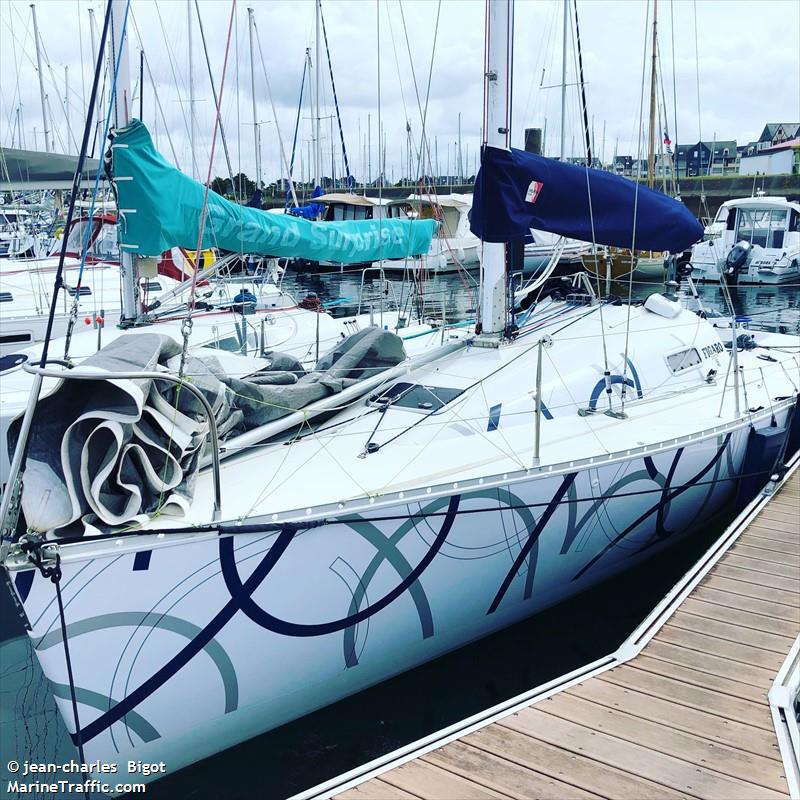Japanese authorities investigating deadly ship collision that killed seven US Navy personnel

Japanese authorities are now investigating how an NYK chartered boxship slammed into the side of a US Navy destroyer over the weekend with the loss of seven American soldiers. The ACX Crystal smashed into the USS Fitzgerald at around 2.20 am on Saturday in Japanese waters.
“The damage was significant. This was not a small collision,” US 7th Fleet Commander Vice Admiral Joseph Aucoin said at a press conference in Yokosuka yesterday.
Aucoin declined to comment on how the accident happened however Reuters is reporting that Japanese authorities are investigating “endangerment of traffic caused by professional negligence”.
Japanese media also reported that the ACX Crystal made a “sharp turn” just before the crash.
The 20 Filipino crew onboard the ACX Crystal are being interviewed by Japanese investigators.
Aucoin related how the smash saw the destroyer’s hull open up and quickly flood three large compartments that included two berthing areas for 116 crew members. The destroyer’s captain was injured in the collision and airlifted to hospital. Meanwhile, the 300-odd crew remaining on the Fitzgerald managed to contain the flood and navigate the ship back to port using a magnetic compass and backup equipment.
The Philippine-flagged boxship appears to have sustained some damage to its bow but has managed to continue on its voyage, offloading containers in Tokyo yesterday and heading for Yokohama today.
“NYK and the shipowner are fully cooperating with an investigation being conducted by the Japan Coast Guard. More information will be provided when known,” NYK said in its third update on the crash.
The moment of the #ACXCrystal collision with #USSFitzgerald . Replay the full past track here: https://t.co/NAiMZ98iYo pic.twitter.com/G9zl1AJPc2
— MarineTraffic (@MarineTraffic) June 17, 2017

 smashed into the USS Fitzgerald at around 2.20 am on Saturday in Japanese waters.
smashed into the USS Fitzgerald at around 2.20 am on Saturday in Japanese waters.
This will likely be one of the US Navy’s toughest day’s (in peacetime) in recent memory. A billion dollar top of the line destroyer suffers extensive damage, with death and injuries inflicted upon the crew. The FITZGERALD was simply in transit in a coastwise shipping lane and it appears (as is a routine practice) that she had her own AIS turned off. Thus, there is no historical trackline to observe today. Why the Navy engages in this practice is going to be one of many questions that investigators will ask. The idea that having your AIS turned ‘off’ in an effort to maintain some degree of stealth operating ability is rather foolish. Yet we see this off Pearl Harbor Hawaii all the time.
Some media sources are already claiming the collision happened an hour later than reported. Some self proclaimed ‘defense experts’ are also alleging there was no mate on the bridge of the CRYSTAL. How these fools can make such accusations is truly stunning in revealing how little some people know about our industry and how we seafarers function at sea.
Here are some facts that are unique to all US Navy ships.
1) There are likely more crew standing on the bridge of a Navy ship while underway, then are onboard the entire civilian ship. Imagine the atmosphere of the bridge where 20+ people are required to maneuver your ship safely through a coastwise transit such as they were. The ultimate worse possible bridge environment you can have, the Navy employs on purpose. This needs to change.
2) The person that was the designated “officer of the watch” was likely going through a training evolution while underway. The Navy typically has numerous ‘training evolutions’ occurring at any one time, while underway at sea. It’s the whole point of them being at sea. “Training” is what is happening all the time, constantly. So the individual who actually was in charge of maneuvering the ship and had the authority to direct the movements of the FITZGERALD, may not have had much experience in being in this role.
3) An incident at 0230 in the morning is no surprise. We who have attended a Bridge Resource Management (BRM) class will all tell you, it’s the worse possible time for human thought process and mental clarity. Most Navy ship officers do NOT stand a routine watch like civilians of 4 hours on and 8 hours off. They roll through a watch system that does NOT have routine sleep and work schedules built in. So the individual working as the Officer of the Deck may have been even more tired than most.
4) Most people would be ‘stunned’ by the actual LACK of modern navigation equipment on the bridge of most Navy ships. Moreover, the OOD typically is relying on a constant barrage of information relayed to him verbally by other individuals assigned specific tasks (navigating, VHF comms, lookout, engine control). One can see in the environment of heavy vessel traffic, this can become very tense very quickly. The OOD is not normally availing him(her)self to actually looking at an ECDIS, if they even have one on the bridge, directly. Another individual is likely looking at the unit and verbally sharing information to the OOD. It’s a helluva way to run a ship.
I’ve been a US Navy Reserve officer for 6 years after graduating from a Maritime Academy. I’ve also handled many US and foreign Navy ships in ports throughout Hawaii as a Harbor Pilot (23 years). I also spent over a year working with US Civilian Pilots employed in Pearl Harbor riding as an observer to obtain ‘pilotage’ endorsement for the waters of Pearl Harbor. So my opinions are based on my personal direct knowledge and experience first hand. Not speculation.
I have always advocated whenever the opportunity allows, that the US Navy Admirals and Pentagon command structure, take a serious look at just how we choose to man the bridge of a Naval vessel. Secondly, the level of experience that Naval Officers possess is determined by a structured career ‘path’ that (to me at least) makes little sense. Officers are moved every 2 or 3 years from a shoreside billet to a seagoing billet. The constant interruption of their skills and their routine transformation from one job/task to another may work well for a lifetime of a career naval officer who is well rounded in a variety of missions. But it creates an individual who can do a lot of things adequately but few things that can be done with any expertise.
Driving a billion dollar US Navy Combatant platform in the crowded waters off the coast of Japan, at night, surrounded by hundreds of other large civilian ships, and throw in hundreds more of small fishing vessels surrounding you in a sea of small white lights, most drifting, some actually moving around…this is no place for the timid or an individual who hesitates to make an instantaneous decision. As many other civilian mariners will attest to, standing watch on civilian cargo ship, by yourself, with only a helmsman at the wheel who also may be the lookout at the same time, while the Captain is asleep below, this can make for a very busy watch. You are on your feet the entire time running around taking a fix, watching traffic ahead, making waypoint turns, filling in your logbook and keeping track of administrative demands, adjusting speeds to ensure your proper ETA, being in contact with shoreside pilot/traffic stations…. the list is seemingly endless…but the four hours go by rather quickly. Exhaustion overwhelms you when you walk away from the bridge and head below. Contrast that atmosphere to the bridge of a naval vessel with 20+ people around all talking, spoon feeding info to you constantly.
One positive thing that “could” evolve from this incident, is a review of practices and procedures of manning and duties on the bridge of US Navy vessels. But I doubt it. Stuck in the ‘old school and traditional mentality’ and “this is how we have always done it” mindset, will get us nowhere. How many more accidents will have to occur before the Admirals Staff wakes up to a new reality?
Ed,
First, it’s not just the USN…
I very clearly recall the last time I set eyes on a “twiddle the dials” Decca set; it was in the wheelhouse of an RN warship, long after merchant ships had dumped them, and I use the term “wheelhouse” because that was what it was – the chart room was two doors away (yes, it would have made more sense to put the Decca set over the chart table, if they had to have one at all..) This was not an old ship; just a ship that was out of date before she was launched.
Because their fuel is paid for by irritated taxpayers, warships spend much of their lives alongside, in port. Because of the Naval pattern of assigning crew to ships for long periods of time, the ship’s company try to “wangle” time at their home port so that they can see their families. It’s all very pleasant, but…
Second, this is by no means the first collision between a warship and a merchant vessel, and the history of decided cases shows us that, whatever the merits of this matter may prove to be, in many cases the warship was largely at fault. Again, by no means confined to the USN…
your assuming the Navy was wrong in this case? Am I correct? All of your experience do not justify speculation. Why don’t you wait until the results of the investigation reveal the facts rather than speculating?